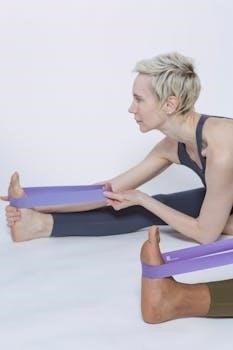IT Band Syndrome Exercises⁚ A Comprehensive Guide
This guide provides a comprehensive overview of exercises
to manage IT Band Syndrome. It includes stretching,
strengthening, and foam rolling techniques to relieve
pain and improve flexibility. Follow these
exercises, tailored for effective rehabilitation and
prevention, to regain comfort and mobility.
What is IT Band Syndrome (ITBS)?
IT Band Syndrome (ITBS) is a common overuse injury,
particularly among athletes and runners. It involves
inflammation and pain in the thigh, knee, and hip’s
outer region. This condition arises from repetitive
friction of the iliotibial band, a thick tendon running
from the pelvis to the shin bone, against the lateral
femoral epicondyle.
The irritation occurs as the IT band rubs back and forth
during knee motion, leading to pain and discomfort.
Activities involving repetitive knee flexion and extension,
such as running, cycling, and hiking, often exacerbate
the symptoms. The syndrome is characterized by sharp or
burning pain on the outside of the knee, which can radiate
up the thigh.
ITBS is not merely a tightness issue; biomechanical factors,
muscle imbalances, and improper training techniques can
contribute. Addressing these underlying causes is crucial for
effective management and prevention of ITBS.
Anatomy of the Iliotibial (IT) Band
The Iliotibial (IT) band is a thick, fibrous band of
tissue that extends along the outside of the thigh,
playing a crucial role in stabilizing the knee during
movement. Originating at the hip from the tensor fasciae
latae (TFL) and gluteus maximus muscles, it runs down
the lateral aspect of the thigh and inserts just below the
knee on the tibia.
This band functions as a strong stabilizer, assisting in
hip abduction, external rotation, and knee flexion and
extension. Unlike a muscle, the IT band is primarily
composed of collagen fibers, making it less elastic and
more prone to tightness or friction.
Its anatomical position and function make it susceptible
to overuse injuries like IT Band Syndrome, where repetitive
movements cause irritation as it rubs against the lateral
femoral epicondyle. Understanding its anatomy is essential
for effectively targeting stretches, strengthening exercises,
and foam rolling techniques to alleviate ITBS symptoms;
Common Causes of ITBS
Iliotibial Band Syndrome (ITBS) is commonly triggered
by overuse and repetitive movements, particularly in
activities like running and cycling. Several factors
contribute to its development, including anatomical
issues such as leg length discrepancies or excessive
pronation of the foot, which alter biomechanics.
Inadequate flexibility and weakness in hip abductor
muscles, such as the gluteus medius, lead to increased
tension on the IT band. Improper training techniques,
like rapidly increasing mileage or running on sloped
surfaces, exacerbate the condition. Worn-out shoes
or insufficient warm-up routines also play a role.
Tightness in the IT band itself, caused by lack of
stretching, restricts its normal motion, leading to
friction against the lateral femoral epicondyle. Addressing
these factors through targeted exercises, proper footwear,
and gradual training adjustments can effectively prevent
and manage ITBS.

Stretching Exercises for IT Band Syndrome
Effective stretching is crucial for IT Band Syndrome
relief. These exercises increase flexibility, reducing
tension and friction. Regular stretching helps restore
normal IT band movement, alleviating pain and promoting
healing.
Standing IT Band Stretch
The standing IT band stretch is a simple yet effective way to increase flexibility and reduce tension in the iliotibial band. Begin by standing with your feet shoulder-width apart. Next, cross the uninjured leg in front of the injured leg, ensuring your weight is evenly distributed between both feet.
Gently bend down, reaching towards your toes. You should feel a stretch along the outside of your injured thigh. To deepen the stretch, you can move your hands across the front of your feet towards the uninjured side.
Hold this position for approximately 30 seconds, maintaining a comfortable stretch without pushing yourself into pain. Slowly return to the starting position and repeat the stretch 3-5 times. Regular practice of this stretch can significantly improve IT band flexibility and alleviate symptoms of IT band syndrome.
Remember to listen to your body and avoid overstretching, as this can exacerbate the condition. This standing stretch is convenient and can be performed anywhere, making it an excellent addition to your daily routine for managing IT band issues.
Side-Leaning IT Band Stretch
The side-leaning IT band stretch is another effective technique to target the iliotibial band and improve its flexibility. To begin, stand next to a wall with the side you intend to stretch facing it. Cross your uninjured leg in front of the leg you are planning to stretch, ensuring your weight is evenly distributed between both feet.
Place the hand closest to the wall on the wall for support. Next, gently lean your hips towards the wall, allowing your affected hip to drop out to the side. Simultaneously, lean your upper body away from the wall, increasing the stretch along the IT band.
For an intensified stretch, raise the arm that is against the wall overhead as you lean away from your hip. Hold this position for about 30 seconds, focusing on feeling the stretch along the outside of your thigh. Repeat this stretch 3-5 times.
This side-leaning stretch is particularly useful for targeting the IT band while also engaging the surrounding muscles. Regular practice can help alleviate tightness and reduce pain associated with IT band syndrome. Remember to avoid pushing yourself too far and listen to your body to prevent further irritation.

Strengthening Exercises for IT Band Syndrome
Strengthening exercises are vital for IT band syndrome
rehabilitation. They focus on the hip and gluteal
muscles, providing stability and reducing strain on the
IT band. Consistent strengthening helps prevent
recurrence and improves overall lower body function.
Lateral Walks with Exercise Band
Lateral walks with an exercise band are a highly effective strengthening exercise for IT band syndrome, targeting the hip abductors, particularly the gluteus medius. Strong hip abductors are crucial for stabilizing the pelvis and preventing excessive inward movement of the knee, which can contribute to IT band friction. To perform this exercise correctly, place an exercise band around your ankles or knees, ensuring there’s tension even when your feet are close together.
Begin in a slightly squatted position to engage the glutes. Maintain a straight back and avoid leaning forward. Step sideways, keeping the band taut, and focus on controlled movements. Avoid letting the band snap back as you move. Take about 10-15 steps in one direction, then reverse and walk back to the starting point.
This exercise can be modified to increase difficulty by using a stronger resistance band or lowering deeper into the squat. Remember to maintain proper form throughout the exercise to maximize effectiveness and prevent injury. Consistent practice of lateral walks can significantly improve hip strength and reduce IT band pain.
Clamshell Exercise
The clamshell exercise is a targeted movement designed to strengthen the hip abductors, particularly the gluteus medius, which plays a crucial role in stabilizing the pelvis and preventing excessive knee movement that can exacerbate IT band syndrome. To perform the clamshell exercise, lie on your side with your hips and knees bent at a 45-degree angle, keeping your feet stacked on top of each other. Engage your core to stabilize your spine and prevent any rolling backward.
Keeping your feet together, slowly lift your top knee away from the bottom knee, resembling the opening of a clamshell. It’s important to maintain a neutral pelvis throughout the movement, avoiding any backward tilting. Focus on using your gluteus medius to initiate and control the movement. Hold the open position for a brief moment, feeling the contraction in your hip, and then slowly lower your knee back to the starting position.

Repeat this movement for 10-15 repetitions on each side. To increase the intensity, you can add a resistance band around your thighs, just above your knees. The clamshell exercise helps improve hip stability, reducing stress on the IT band and alleviating pain associated with IT band syndrome.

Foam Rolling for IT Band Syndrome
Foam rolling helps mobilize the IT band,
reducing tightness and friction. Regular foam rolling
can alleviate pain and improve flexibility,
supporting overall IT band health. It’s an
important part of managing IT band syndrome.
IT Band Mobilization with Foam Roller
Foam rolling the IT band is a crucial technique for addressing tightness and discomfort associated with IT Band Syndrome. To perform this mobilization, lie on your side with the foam roller positioned under your affected thigh, just above the knee. Cross your top leg over for support and use your arms to stabilize your body. Gently roll from just above the knee up towards the hip, applying moderate pressure.
Focus on areas where you feel tightness or tenderness. Remember to maintain a straight body alignment, avoiding bending at the hips. This exercise may cause some discomfort, and even bruising, especially initially. Adjust the pressure as needed, using your supporting leg and arm to offload weight.
Perform this exercise for approximately 30-60 seconds, repeating for 3 sets. Consistent foam rolling can help break down adhesions, improve tissue flexibility, and reduce friction between the IT band and the lateral epicondyle.
It is essential to combine foam rolling with other stretching and strengthening exercises for comprehensive IT Band Syndrome management. Listen to your body and discontinue if you experience severe pain.
